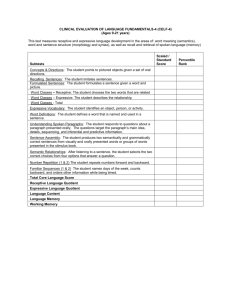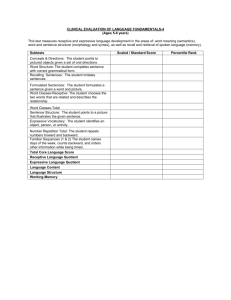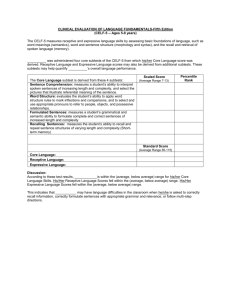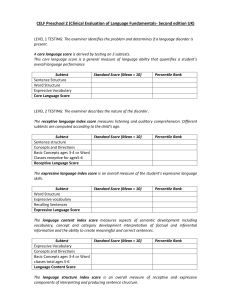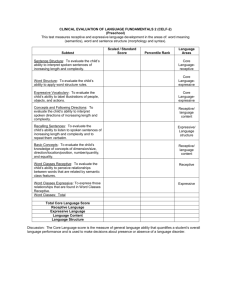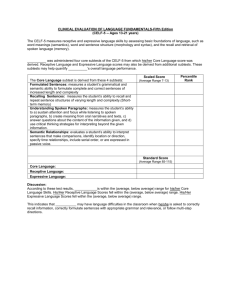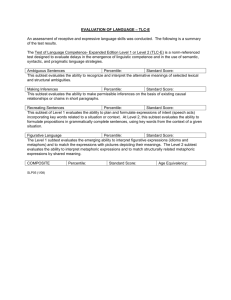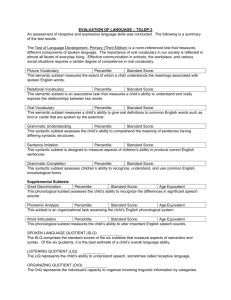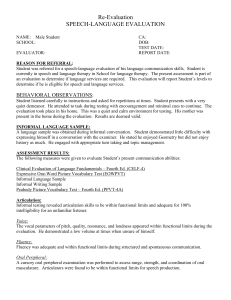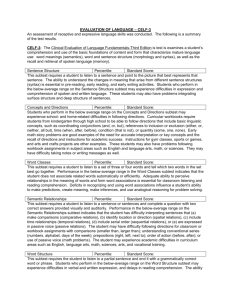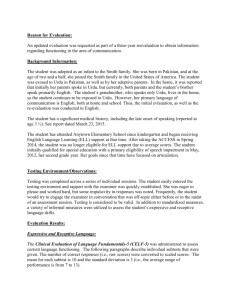CELF-4 Ages 5-8
advertisement
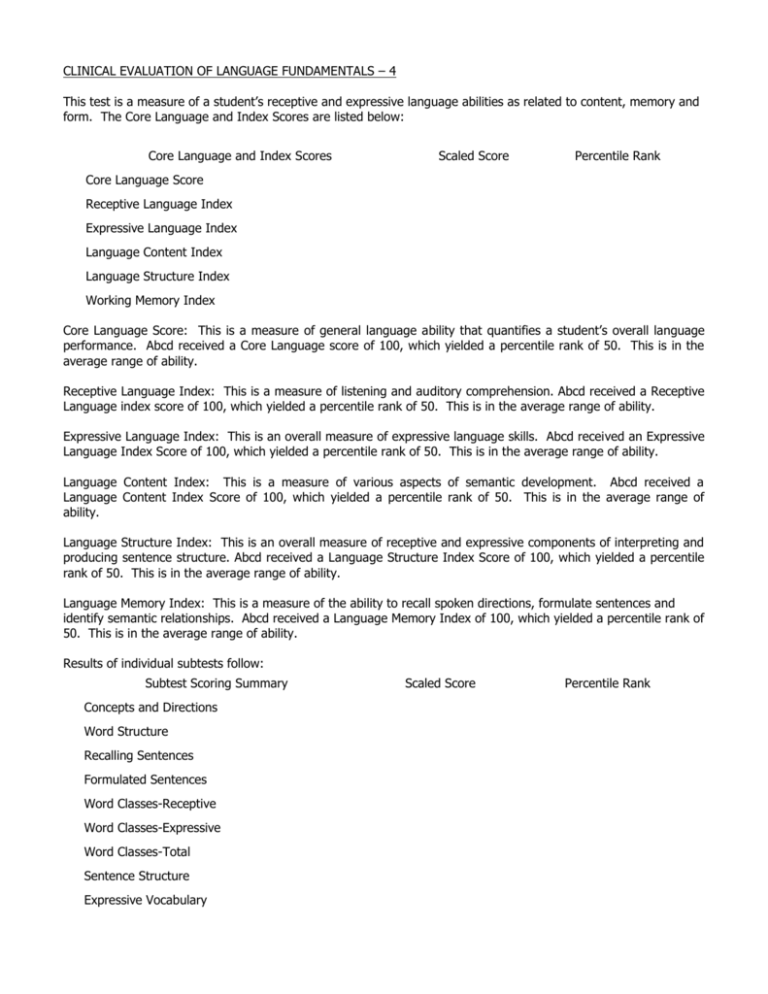
CLINICAL EVALUATION OF LANGUAGE FUNDAMENTALS – 4 This test is a measure of a student’s receptive and expressive language abilities as related to content, memory and form. The Core Language and Index Scores are listed below: Core Language and Index Scores Scaled Score Percentile Rank Core Language Score Receptive Language Index Expressive Language Index Language Content Index Language Structure Index Working Memory Index Core Language Score: This is a measure of general language ability that quantifies a student’s overall language performance. Abcd received a Core Language score of 100, which yielded a percentile rank of 50. This is in the average range of ability. Receptive Language Index: This is a measure of listening and auditory comprehension. Abcd received a Receptive Language index score of 100, which yielded a percentile rank of 50. This is in the average range of ability. Expressive Language Index: This is an overall measure of expressive language skills. Abcd received an Expressive Language Index Score of 100, which yielded a percentile rank of 50. This is in the average range of ability. Language Content Index: This is a measure of various aspects of semantic development. Abcd received a Language Content Index Score of 100, which yielded a percentile rank of 50. This is in the average range of ability. Language Structure Index: This is an overall measure of receptive and expressive components of interpreting and producing sentence structure. Abcd received a Language Structure Index Score of 100, which yielded a percentile rank of 50. This is in the average range of ability. Language Memory Index: This is a measure of the ability to recall spoken directions, formulate sentences and identify semantic relationships. Abcd received a Language Memory Index of 100, which yielded a percentile rank of 50. This is in the average range of ability. Results of individual subtests follow: Subtest Scoring Summary Concepts and Directions Word Structure Recalling Sentences Formulated Sentences Word Classes-Receptive Word Classes-Expressive Word Classes-Total Sentence Structure Expressive Vocabulary Scaled Score Percentile Rank Understanding Spoken Paragraphs Number Repetition-Forward Number Repetition-Backward Number Repetition-Total Familiar Sequences 1 A discussion of each subtest follows: Concepts and Directions: This subtest measures the ability to interpret spoken directions of increasing length and complexity, containing concepts that require logical operations. Students who perform below average often have difficulty following directions for seatwork and projects; remembering homework assignments; and following teacher instructions for managing classroom activities and interactions. Word Structure: This subtest measures the ability to apply word structure rules (grammar) and select and use appropriate pronouns to refer to people, objects and possessive relationships. Students who perform below average often have difficulty substituting pronouns for nouns; indicating number, time and possessive relationships; making comparisons of characteristics; and describing pictures and events. Recalling Sentences: This subtest measures the ability to listen to sentences of increasing length and complexity and repeat them without changing word meanings or sentence structure. Students who perform below average often have difficulty following directions, writing to dictation, taking notes, learning vocabulary and subject content. Formulated Sentences: This subtest measures the ability to formulate complete, semantically and grammatically correct spoken sentences of increasing length and complexity, using given words and contextual constraints imposed by illustrations. Students who perform below average often have difficulty forming simple, compound, and complex sentences, and producing them orally or applying them in creation of written text. Word Classes-Receptive and Expressive: These subtests measure the ability to understand and explain relationships between words. Students who perform below average often have difficulty using word associations to pair words with shared or opposite meanings, substituting synonyms for earlier acquired word forms and facilitating word retrieval. Sentence Structure: This subtest evaluates the ability to understand spoken sentences of increasing length and complexity and select the pictures to illustrate the meaning of the sentence. Students who perform below average often have difficulty understanding relationships between spoken language and real-life situations. Expressive Vocabulary: This subtest measures the student’s ability to name pictures of people, objects, and actions. Students who perform below average may have difficulty labeling and remembering names for people, objects and actions and using them to express concise meaning in spontaneous situations. Understanding Spoken Paragraphs: This subtest measures the ability to sustain attention and focus while listening to spoken paragraphs of increasing length and complexity; interpret information and think critically to arrive at logical answers. Students who perform below average exhibit difficulties in classroom listening and reading comprehension. These students may have difficulty retaining facts and details and understanding implied meaning. Number Repetition-Forward/Backward: This subtest measures the ability to repeat random number sequences of graduated length. This task requires attention, concentration and auditory/verbal working memory. In the classroom, students who perform below average may have difficulty attending or sustaining attention long enough for learning to occur.
